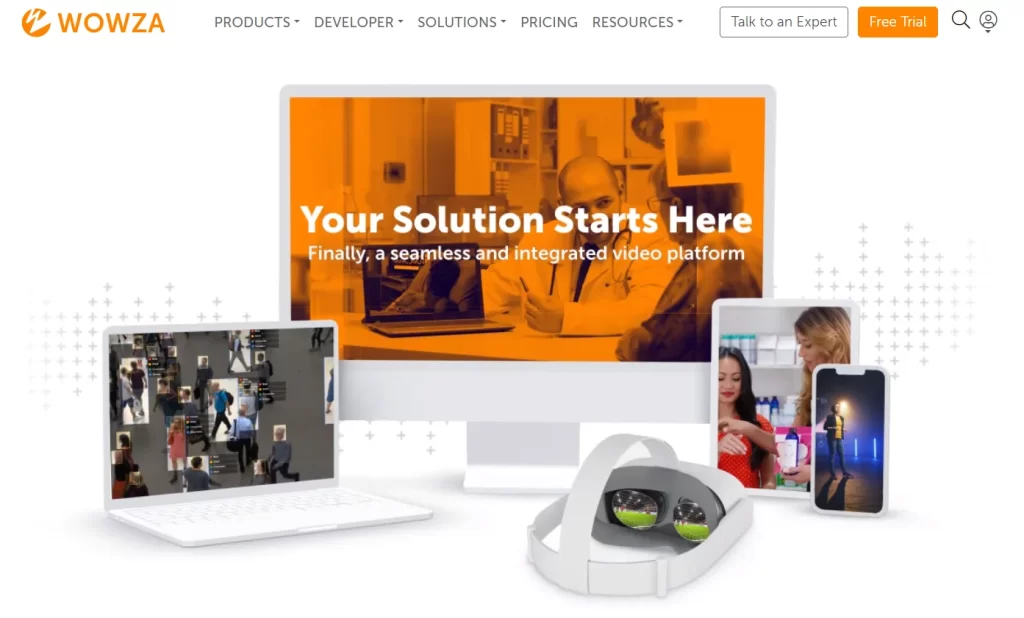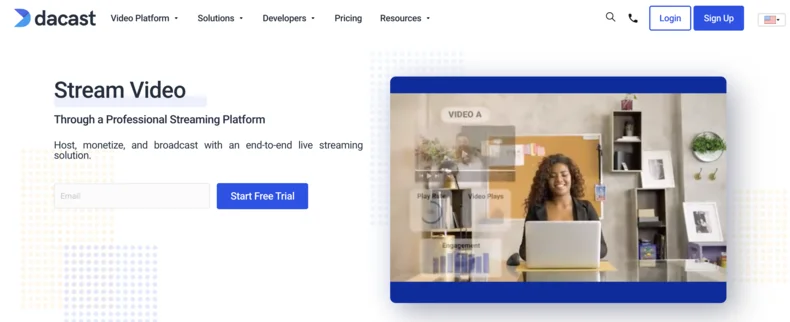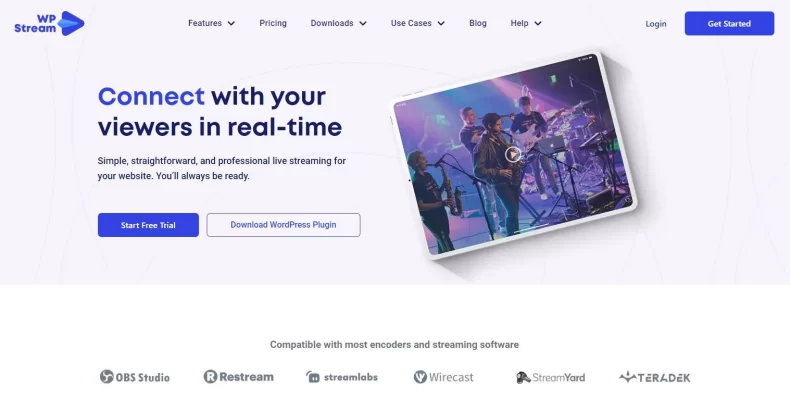Last modified: June 12 , 2024
Latency refers to the delay between the capture of a live event and when the viewer sees it, which can be a big stumbling block when it comes to live streaming.
High latency can lead to a disjointed viewer experience, causing frustration and potentially leading to viewers abandoning your stream altogether. As our digital world becomes faster and more interconnected, the expectation for real-time interaction has grown.
This is where low latency streaming becomes more important than ever, as a crucial element in delivering a seamless and engaging viewer experience. It bridges the gap between content creators and viewers, making live interactions feel more like face-to-face conversations.
In this guide, we will demystify low latency streaming, explain its importance, how to achieve it, and the best streaming services to help you deliver a real-time viewer experience. Buckle up as we dive into the fast-paced world of low latency streaming!
Understanding low latency streaming
In the realm of live video streaming, the term ‘latency’ is often tossed around. But what exactly does it mean? Simply put, latency in the context of streaming refers to the time delay between the moment the camera captures video and when that video is displayed on the viewers’ devices. It’s the time it takes for your video to travel from source to destination.
Some degree of latency is unavoidable in live streaming. This is because there are numerous stages involved in the process of capturing video and converting it into a viewable format for your streaming audience, such as:
- Capturing the video.
- Encoding it.
- Packaging it into a suitable format for streaming.
- Transmitting it over the internet.
- Decoding and displaying it on the viewer’s device.
Each of these steps requires time, contributing to the overall latency.
Ideal video latency for live streaming
When it comes to latency, the lower, the better. However, it’s important to understand the different levels of latency and what they mean for your live streaming experience.
High latency refers to a delay of around 30 seconds or more.
While this might not seem like a lot, in the world of live streaming, it can create a disconnect between the streamer and the audience, making immediate interaction nearly impossible.
On the other hand, low latency is generally defined as a delay of around 5 to 15 seconds.
This level of delay is acceptable for many types of live streams, especially those where live interaction is not a priority.
Then there’s ultra-low latency, the holy grail of live streaming. This typically refers to a delay of less than one second, making it as close to real-time as possible.
Ultra-low latency is crucial for streams that require high levels of viewer engagement and real-time conversations, such as online gambling, auctions, or interactive events.
Higher levels of latency can have a negative impact on the viewer experience. A significant delay can cause viewers to feel disconnected from the event, reducing their engagement and potentially leading them to abandon your stream. Therefore, striving for low or ultra-low latency is often a top priority for those looking to provide a seamless and engaging live streaming experience.
Benefits of low latency streaming
Embracing low latency streaming brings a host of benefits that can significantly enhance the quality of your live streams. Here are some of the key advantages:
Improved viewer satisfaction
By minimizing the delay between the capture of the video and its display on the viewer’s device, you can create a more seamless and enjoyable viewing experience. The audience can watch the event unfold almost in real-time, without any frustrating interruptions like stream buffering or lag.
Increased audience engagement
With a shorter delay, viewers can interact with the streamer, responding to events as they happen. This live interaction can make viewers feel more connected to the streamer and the event, encouraging them to stay engaged for longer periods.
Greater professionalism
Low latency streaming can lend a greater sense of professionalism to your live streams. Buffering, lag, and other delays can disrupt the viewing experience and make your stream appear less professional. By reducing latency, you can provide a smoother, higher-quality stream that reflects well on your brand or organization.
Common use cases for low latency streaming
- Live sports: In live sports streaming, every second counts. Viewers want to see the action as it happens without any delay. Low latency streaming allows sports fans to react to goals, touchdowns, and other key moments as they occur, enhancing their viewing experience.
- Interactive events: For interactive events like webinars, conferences, and Q&A sessions, low latency streaming is essential. It allows participants to ask questions, respond to polls, or engage in discussions with minimal delay, creating a more interactive and engaging experience.
- Live auctions/commerce: In live auctions or eCommerce events, immediate interaction is key. Low latency streaming allows bidders to place bids like they are present at the venue, creating a more exciting and dynamic auction experience.
- Gambling: In online gambling, decisions need to be made quickly and immediately. Low latency streaming ensures that players can place bets and react to changes in the game without any delay.
Achieving low latency: Key factors
Achieving low latency is not a single-step process. It involves optimizing every stage in the streaming pipeline, from video capture to content delivery. Here are some of the key factors and technical requirements that can help you achieve low latency:
1. Choose the right encoder
The choice of encoder plays a significant role in determining your stream latency. An encoder converts the raw video input into a digital format suitable for streaming, and modern hardware encoders are capable of maintaining low latency while still delivering high picture quality. They use advanced compression algorithms to reduce the size of the video data, enabling it to be transmitted more quickly and efficiently.
2. Choose the right streaming protocol
Streaming protocols represent a set of guidelines that dictate how multimedia is transmitted over the internet. They define the manner in which data is sent between communicating systems, and choosing the right one can be pivotal to providing an optimal viewer experience. Here is an overview of some frequently used streaming protocols.
WebRTC
Web Real-Time Communications (WebRTC) is lauded for its low latency and flexibility. Supported by modern browsers and providing excellent video quality through VP8, VP9, and H.264 codecs, WebRTC can navigate firewalls without losing quality. Its adaptable bit rate technology prevents drops and interruptions, making it a superb choice for real-time data transfer and video conferencing.
SRT
Secure Reliable Transport (SRT) is an open-source video transport protocol aimed at enhancing streaming performance across inconsistent networks. By adjusting to real-time network conditions, SRT reduces packet loss and ensures a higher Quality of Experience (QoE). Its easy firewall traversal enables top-quality live video over unstable networks.
LL-HLS
Apple’s Low Latency HLS (LL-HLS) is a revised protocol allowing partial segment generation, thereby reducing latency. Its use of the tag #EXT-X-PRELOAD-HINT streamlines player-server communication and makes bandwidth measurement simpler, resulting in sub-2-second latency.
UDP and TCP
UDP (User Datagram Protocol) is a connectionless and fast communication protocol often used in web browsing, email, and file transfer where low latency is prioritized over reliability. However, it doesn’t guarantee the delivery of data packets nor provide error recovery if a packet is lost.
TCP (Transmission Control Protocol) establishes a reliable connection using a three-way handshake and includes error recovery. Typically utilized in online games, live streaming, and VoIP, TCP guarantees ordered delivery but may be slower than UDP. The choice between these two depends on the specific need for speed versus reliability in the application.
RTMP
The Real Time Messaging Protocol (RTMP) continues to be a favorite despite the depreciation of Adobe Flash Player. Offering low-latency streaming and minimal buffering, RTMP is still used by popular platforms like YouTube and Twitch.
Choosing the right streaming protocol involves understanding the specific requirements of the content, audience, and devices being used. Providers must carefully assess the trade-offs between different protocols, considering factors like latency, quality, compatibility, and the underlying network conditions.
For those focusing on ultra-low latency and high quality, WebRTC or SRT might be the ideal choice. If compatibility and standards compliance are priorities, LL-HLS could be a better fit. For a balance between reliability and speed, RTMP might be the best option.
3. Use the right CDN provider
The CDN provider you choose can significantly influence your stream latency. A robust CDN ensures that you can deliver content to a larger number of viewers faster and more reliably with less bandwidth usage. CDNs do this by distributing your content across a network of servers located in various geographic locations.
When a viewer requests access to your stream, the CDN delivers it from the server closest to the viewer, reducing the time it takes for the video data to travel. This helps to reduce buffering, eliminate lagging issues, and improve stream scalability.
Choosing the right streaming service for low latency
While there is an extensive range of streaming platforms available on the market, not all of them efficiently offer low latency streaming without compromising on video quality. Therefore, it’s crucial to carefully consider your options when choosing a streaming service for low latency. Here are some key factors to consider:
- Ease of use: The streaming platform you select should be user-friendly, with a straightforward setup process and intuitive controls. This will allow you to focus more on the content you’re streaming and less on the technical aspects of the platform.
- Reliability: Your chosen platform should have a proven track record of reliability. The last thing you want during a live stream is to experience technical issues or downtime. Look for a service with robust infrastructure and strong customer support to quickly address any issues that may arise.
- Scalability: As your audience grows, your streaming platform should be able to scale with you. Look for a service that can handle an increase in viewers without compromising on speed or video quality.
- Competitive pricing: Lastly, consider the cost. While low latency and high video quality are important, you also want to ensure that the service fits within your budget. Look for a platform that offers competitive pricing without compromising on key features.
By taking these factors into account, you can choose a streaming service that not only offers low latency but also meets your specific needs and requirements.
Top streaming platforms for low latency streaming
When it comes to low latency streaming, not all platforms are created equal. Let’s delve into some of the best low latency streaming solutions on the market, comparing them in terms of their features, ease of use, reliability, scalability, and pricing.
WpStream
WpStream stands out as a top choice for low latency streaming. This powerful plugin offers a host of features that make it an excellent choice for a wide range of use cases.
From its easy extendability and customization to its range of content monetization options, WpStream is designed to deliver a superior streaming experience.
- WpStream works with all streaming setups, from a simple smartphone or laptop camera to professional broadcasting equipment. You can set up your stream and start broadcasting in a matter of minutes, making it an exceptionally user-friendly choice.
- It uses a multi-CDN solution to ensure your stream content is delivered reliably and at high speed, regardless of where your viewers are watching from. This means you can count on WpStream to deliver a smooth, uninterrupted viewing experience for your audience.
- WpStream offers scalable plans to meet your needs. The platform also integrates with all major streaming software via an RTMP connection, making it easy to extend your setup as your requirements change.
WpStream embraces an array of streaming protocols to deliver optimal viewing experiences. Utilizing RTMP and WebRTC for broadcasting, it ensures robust and adaptable streams. HLS is employed for standard latency playback, offering consistent quality, while LL-HLS brings forth low-latency viewing for real-time engagement.
For those craving the cutting edge, WpStream’s closed beta of WebRTC for ultra-low-latency playback pushes boundaries, providing an immediate connection between broadcasters and audiences.
Pricing for the plugin starts from $19 per month, and a free trial is available for those who want to test out the platform’s capabilities. All plans include the full feature set of the plugin, ensuring you have access to all the tools you need to deliver a top-notch streaming experience.
Wowza
Wowza is a well-known name in the streaming industry, promising near real-time video streaming at scale. It offers a suite of professional-grade streaming solutions, including the Wowza Streaming Engine and Wowza Streaming Cloud, both of which support low latency streaming.

Wowza’s platform scores high on ease of use, with a user-friendly interface and comprehensive documentation. It’s also reliable, with robust infrastructure and 24/7 monitoring to ensure smooth streaming. In terms of scalability, Wowza can handle streams of any size, making it a good option for growing broadcasters.
However, Wowza’s pricing structure may be a barrier for some users. Its standard plans bill usage separately, which could make it a more expensive option for newer streamers looking to grow their audience. In contrast, WpStream includes all features in its plans, making it a more cost-effective choice.
Dacast
Dacast is another popular streaming solution that offers low latency streaming as part of its standard offering. The platform promises an average reduction of latency to 10 seconds or less, making it a good option for broadcasters who prioritize live interaction.

Dacast offers a range of features, including live and on-demand streaming, monetization options, and comprehensive analytics. It also scores well on ease of use and reliability, with a user-friendly interface and 24/7 support.
However, Dacast’s pricing may be a sticking point for some users. Not all features are included as standard, and its plans are more expensive than some other options on the market.
Ensure a low latency livestream with WpStream
In the world of live streaming, low latency is the key to delivering real-time, interactive experiences that keep your viewers engaged. Achieving low latency requires careful consideration at every step of the streaming process, from choosing the right encoder and streaming protocol to selecting a robust CDN provider.
Moreover, the streaming platform you choose plays a pivotal role in your ability to deliver low latency streams. It’s important to select a platform that’s designed to offer low latency streaming without compromising on video quality, ease of use, reliability, scalability, or pricing.
WpStream emerges as the best choice in this regard. It’s a comprehensive, user-friendly platform that offers low latency streaming, robust features, and competitive pricing. Whether you’re a beginner or a seasoned broadcaster, WpStream is designed to meet your needs and grow with you.
Ready to experience the difference low latency can make in your live streams? Try out WpStream with a free trial today!
Table of Content








